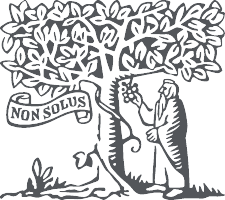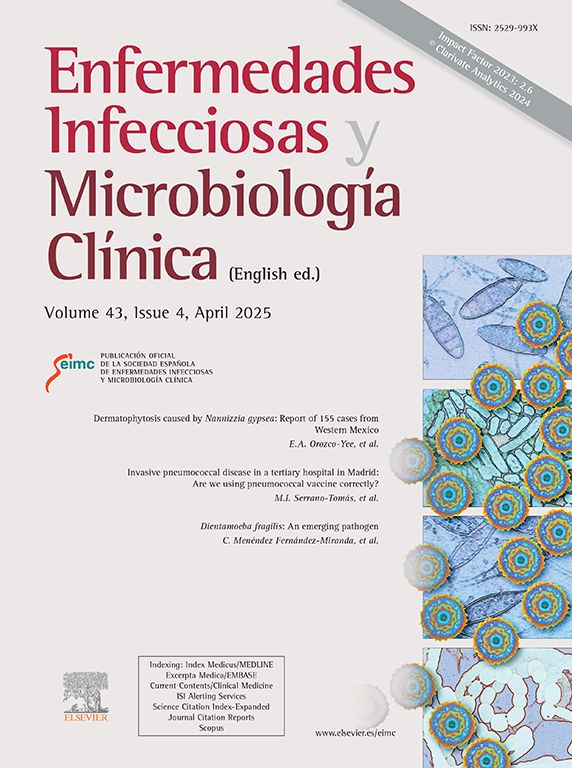Water sample culturing is the reference method to detect Legionella spp. in sanitary facilities. Until 2017, UNE-EN ISO 11731 only included the GVPC medium, which inhibits interfering microbiota but hinders the growth of Legionella spp. To improve its recovery, the new standard incorporates the BCYE medium into the working protocol.
MethodsWe inoculated 1306 sanitary water samples onto BCYE and GVPC according to an accredited internal procedure. We compared the number of cfu/L of Legionella spp. detected in both media.
ResultsThe median in BCYE was 2000 cfu/L higher than in GVPC (P = .000). In the presence of high amounts of interfering microbiota, both media were similar; in the absence or low interfering microbiota BCYE was four times more sensitive than GVPC (P = .000).
ConclusionIncluding BCYE in the analysis of sanitary water significantly improves the recovery of Legionella spp. in low contaminated samples.
El cultivo de muestras de agua es el método de referencia para detectarLegionella spp. en instalaciones sanitarias. Hasta 2017, la UNE-EN ISO 11731 solo incluía el medio GVPC, capaz de inhibir microbiota interferente, aunque dificulta el crecimiento de Legionella spp. Para mejorar su recuperación la nueva norma incorpora el medio BCYE al protocolo de trabajo.
MétodosInoculamos en BCYE y GVPC 1.306 muestras de agua sanitaria según procedimiento interno acreditado. Comparamos el número de ufc/L de Legionella spp. detectados en ambos medios.
ResultadosLa mediana en BCYE fue 2000 ufc/L mayor que en GVPC (P = ,000). En presencia de elevada cantidad de microbiota interferente, ambos medios fueron similares; Con escasa microbiota interferente BCYE fue cuatro veces más sensible que GVPC (P = ,000).
ConclusiónIncluir BCYE en el análisis de agua sanitaria mejora significativamente la recuperación de Legionella spp. en muestras poco contaminadas.
Legionellosis is mainly caused by Legionella pneumophila serogroup 1, although other species such as Legionella anisa can also cause the disease.1,2Legionella spp. colonise water supply systems and survive as intracellular parasites of amoebae harboured in biofilms.2,3 Microbiological control of the drinking water network is crucial to reduce the risk of infection.4,5 Culture is the gold standard and, until 2017, glycine-vancomycin-polymyxin-cycloheximide agar (GVPC) was the media recommended by current regulations.6 Spanish Royal Decree 487/2022 stipulates health requirements for legionellosis prevention, including the accreditation of laboratories for Legionella spp. analysis, sampling and culture.7 UNE-EN ISO 11731:2017 establishes different selective (GVPC, modified Wadowsky–Yee [MWY] and buffered charcoal yeast extract [BCYE] with cefazolin, polymyxin B and natamycin [BCYE + AB]) and non-selective (BCYE) culture procedures and media.8 The choice of culture method affects the results of the analysis and may determine the range of concentrations that guide site control measures.9–11
Material and methodsA comparative study of culture methods for Legionella spp. detection and enumeration in drinking water samples was conducted, evaluating the results obtained in terms of sensitivity and the medium most frequently used to report maximum colony counts. Over a five-year period, 1304 samples were cultured following an accredited in-house procedure (UNE-EN ISO 11731:2007) that included seeding after filtration and elution, without pretreatment (NPT), with acid pretreatment (WAPT) and with heat (WHPT) in BCYE and GVPC media (Becton Dickinson®). A detection limit of 100 cfu/l was established and colonies confirmed as Legionella spp. by inhibition in BCYE-cys were serotyped by latex agglutination (Legionella latex test OXOID®). Quality controls of the culture media were performed to confirm sterility, productivity and selectivity conditions, as per ISO 11133, using reference strains (Legionella pneumophila CECT 7109, Enterococcus faecalis ATCC® 29212, Escherichia coli ATCC® 25922 and Legionella anisa CECT 8177T), which were all within the declared range. The following were used: bivariate analysis to check correlations between parameters, Kolmogorov-Smirnov normality tests, the Mann-Whitney test for two independent samples, Pearson's X2 test and Fisher's exact test to analyse the results obtained and establish correlations between the parameters evaluated (culture medium, pre-treatment method, presence of other microorganisms, free chlorine, pH and temperature).
ResultsIn total, 69% (896) of the samples were positive. The majority species was L. pneumophila serogroup 2–14 (83.8%).
The mean count was 47,185 cfu/l, with a median of 6750 cfu/l. Sensitivity increased using BCYE medium, with higher colony counts reported on 563 occasions with BCYE (63%) vs 333 with GVPC (37%). BCYE is 1.7 times more sensitive than GVPC. Significant differences were found in the number of colonies reported according to the medium used, with the median in BCYE being 2000 units higher than in GVPC (P = .000) (Fig. 1 and Table 1).
Comparison of the median number of cfu/l reported in BCYE and GVPC.
| Comparative analysis mean maximum count | |||||
|---|---|---|---|---|---|
| Total | Mean maximum count in BCYE | Mean maximum count in GVPC | Mann-Whitney test | ||
| cfu/l reported | No. valid | 896 | 563 | 333 | P = .000 |
| Mean | 47,185.38 | 60,391.58 | 24,857.80 | ||
| Standard deviation | 243,474.54 | 300,026.21 | 81,448.35 | ||
| Median | 6,750.00 | 7,700.00 | 5,700.00 | ||
In the presence of a high amount of interfering microbiota, both media were found to be similar; with little or no interfering microbiota, BCYE was four times more sensitive than GVPC (P = .000). No significant differences were found in the distributions of the number of colonies reported according to the accompanying microbiota (P > .05). A lack of preparation (FST) induced the highest number of maximum colony counts in both media (BCYE and GVPC) (P < .000), between 40%–44%, respectively. There were no significant differences according to the physico-chemical characteristics of the samples (pH, chlorine, temperature).
DiscussionIn our study, a significant improvement in Legionella spp. recovery was observed when BCYE was included in the water analysis. Several authors have compared the efficacy of enriched and selective media for isolating Legionella spp. from water samples. Traditionally, selective media such as GVPC, dyes, glycine, vancomycin and polymyxin B (DGVP) and MWY have been shown to be more effective in isolating L. pneumophila, especially in contaminated samples.9–11 However, GVPC medium contains glycine, which can inhibit the growth of other Legionella species, and BCYE medium is proposed as an improvement for their recovery.11 Only Ditommaso et al.12 and Scaturro et al.13 have analysed comparative counts on non-selective (BCYE) and selective (GVPC/MWY) media.
Ditommaso et al.12 demonstrated that the use of BCYE for Legionella spp. enumeration in uncontaminated samples resulted in a higher number of cfu/l reported in 93% of positive samples compared to the use of MWY (P < .001). These results were corroborated by the same authors in 2022, finding a higher frequency of positive samples (94.8%) in BCYE cultures containing only Legionella spp. compared to MWY (85.1%).14 Scaturro et al.13 found a higher percentage of positive samples with GVPC and although the median cfu/l in BCYE were higher than those detected in GVPC (2500 vs. 1350) (P < .0001) not exceeding one logarithm, the authors did not consider it relevant for the risk assessment of the facility. According to our findings, BCYE proved to be four times superior to GVPC in contaminated samples and the median in BCYE was more than three logarithms higher than in GVPC (P = .000). In the mentioned study, 63% of samples in BCYE were reported with the maximum colony count. This is almost double the number of reports compared to GVPC, which was considered relevant for facility control. The authors suggest that the discordance in the results could be related to methodological differences and/or errors.14
Our data show that the performance of BCYE in contaminated samples was not significantly different to GVPC (P > .05). Other studies have also shown that the use of selective media, such as MWY, can be beneficial when culturing samples with interfering microbiota, as they can be better interpreted than BCYE.12,14
Our results, like those published by Ditommaso et al.,12 have demonstrated the efficacy of using BCYE in combination with selective media to control Legionella spp. contamination in healthcare facilities. UNE-EN ISO 11731:2017 has validated this practice by including the combined use of selective and non-selective media.8 In adapting the analysis of water from a drinking water network as per the standard, if performed by seeding after filtration and elution, a non-selective culture medium such as BCYE should be used together with a selective medium such as GVPC.
Ethical considerationsThe study was approved by the ethics committee of the University General Hospital of Valencia (HGUV).
FundingThis study received no specific funding from public, private or non-profit organisations.
Data access declarationAll relevant data are contained within the document and its supporting information files.
Statement on generative AI and AI-assisted technologies in the drafting processDuring the drafting of this paper, the authors used Paperpal to revise the format. After using this tool/service, the authors reviewed and edited the content as necessary and take full responsibility for the content of the publication.
Conflicts of interestThe authors declare that there are no competing interests.









